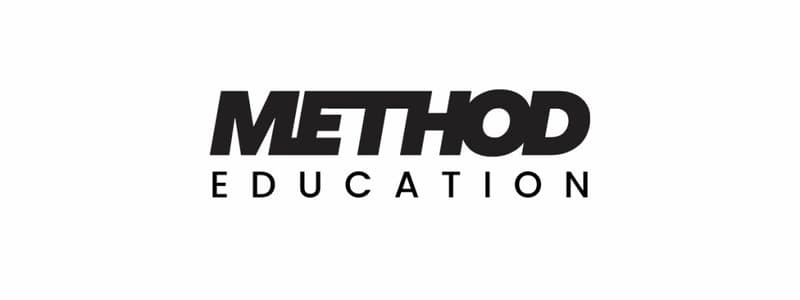Podcast
Questions and Answers
Which exercise is likely to require scaling due to shoulder mobility limitations?
Which exercise is likely to require scaling due to shoulder mobility limitations?
- Air squats
- Deadlifts
- Push jerk (correct)
- Box jumps
What does increased volume of eccentric movement correlate with?
What does increased volume of eccentric movement correlate with?
- Enhanced power output
- Improved muscle flexibility
- Reduced risk of rhabdomyolysis
- Increased risk of rhabdomyolysis (correct)
What phrase summarizes the importance of dosage in exercise?
What phrase summarizes the importance of dosage in exercise?
- More is better.
- Intensity is key.
- All exercises are beneficial.
- The poison is in the dose. (correct)
What is the purpose of scaling movements in training?
What is the purpose of scaling movements in training?
Which of the following is an upper-body pressing movement?
Which of the following is an upper-body pressing movement?
What is the primary goal when scaling CrossFit workouts?
What is the primary goal when scaling CrossFit workouts?
Which metabolic pathways are emphasized in longer workouts?
Which metabolic pathways are emphasized in longer workouts?
What should be avoided when scaling the load of a workout?
What should be avoided when scaling the load of a workout?
What effect does heavy loading in volume have on workout output?
What effect does heavy loading in volume have on workout output?
What indicates a properly scaled workout?
What indicates a properly scaled workout?
During a workout, if a less-experienced athlete takes excessive rest, what is likely affected?
During a workout, if a less-experienced athlete takes excessive rest, what is likely affected?
Why is the duration of effort important when assessing workout effectiveness?
Why is the duration of effort important when assessing workout effectiveness?
How can the original intent of a workout be preserved while scaling?
How can the original intent of a workout be preserved while scaling?
What is generally prioritized over load when scaling a CrossFit workout?
What is generally prioritized over load when scaling a CrossFit workout?
When scaling a workout, which of the following should be considered in addition to loading?
When scaling a workout, which of the following should be considered in addition to loading?
In a time-based workout where the athlete is falling behind the intended pace, what scaling adjustment might be recommended?
In a time-based workout where the athlete is falling behind the intended pace, what scaling adjustment might be recommended?
What role do tactile cues play in scaling workouts?
What role do tactile cues play in scaling workouts?
Why is it important to assess factors such as ROM when scaling workouts?
Why is it important to assess factors such as ROM when scaling workouts?
What is a common issue athletes may face when performing the kipping pull-up?
What is a common issue athletes may face when performing the kipping pull-up?
What should a coach do if athletes repeatedly display improper form during kipping pull-ups?
What should a coach do if athletes repeatedly display improper form during kipping pull-ups?
In what instance should a strict pull-up progression be considered for an athlete?
In what instance should a strict pull-up progression be considered for an athlete?
What coaching approach is suggested for correcting athletes' movement faults?
What coaching approach is suggested for correcting athletes' movement faults?
What should be prioritized when scaling workouts for athletes with injuries?
What should be prioritized when scaling workouts for athletes with injuries?
Flashcards
Scaling CrossFit workouts
Scaling CrossFit workouts
Adapting CrossFit workouts to maintain the intended stimulus while accommodating athletes' limitations, like experience, injury, or mobility.
Range of motion prioritized
Range of motion prioritized
Focusing on the full movement of an exercise, rather than increasing weight, is more important for scaling in CrossFit.
Preserving intended stimulus
Preserving intended stimulus
Making adjustments to workouts to ensure the goal of the workout is achieved despite athlete limitations.
Duration and metabolic pathways
Duration and metabolic pathways
Signup and view all the flashcards
Heavy load, slow output
Heavy load, slow output
Signup and view all the flashcards
Avoid overly quick scaling
Avoid overly quick scaling
Signup and view all the flashcards
Mobility exercises
Mobility exercises
Signup and view all the flashcards
Tactile cues scaling
Tactile cues scaling
Signup and view all the flashcards
Scaling for complexity
Scaling for complexity
Signup and view all the flashcards
Stagnation Prevention
Stagnation Prevention
Signup and view all the flashcards
Athlete Background Considerations
Athlete Background Considerations
Signup and view all the flashcards
Complex before Load
Complex before Load
Signup and view all the flashcards
Safe Range of Motion
Safe Range of Motion
Signup and view all the flashcards
Push Jerk Alternatives
Push Jerk Alternatives
Signup and view all the flashcards
Handstand Push-up Alternatives
Handstand Push-up Alternatives
Signup and view all the flashcards
Partial Squat Scaling
Partial Squat Scaling
Signup and view all the flashcards
Kipping Pull-up Alternatives
Kipping Pull-up Alternatives
Signup and view all the flashcards
Single-arm Dumbbell Thruster
Single-arm Dumbbell Thruster
Signup and view all the flashcards
Box and Chair Usage
Box and Chair Usage
Signup and view all the flashcards
Study Notes
Scaling CrossFit Workouts
- Athletes should prioritize range of motion over load when scaling CrossFit workouts.
- CrossFit workouts are scaled to preserve the intended stimulus, despite athletes' limitations (experience, injury, etc.).
- The duration of the workout determines the primary metabolic pathways trained.
- Heavy loads with high volume can slow output, moving the athlete towards the aerobic pathway.
- Athletes should not be scaled to the point that they work too quickly (remaining primarily in the glycolytic pathway).
- Scaling for range of motion can help preserve the intended stimulus and is part of a larger long-term athlete development plan.
- Scaling should include mobility exercises and movements to improve motor control and positional awareness.
- Scaling might include using objects as tactile cues for movements (e.g., butt target for squat).
- Increased volume of eccentric movements can increase risk of rhabdomyolysis.
- Scaling Complexity:
- Scaling may involve simplifying movements to help athletes progress in difficulty and complexity.
- Coaches shouldn't allow athletes to stagnate at simplified scales.
- Scaling Considerations:
- Consider the athlete's experience, age, and mobility limitations.
- Scale movement complexity before increasing load.
- Monitor athletes and intervene if they reach a safe range of motion limit.
Table 1: Movement Patterns for Scaling
- Lower-body Pulling: Deadlift, power clean, snatch, etc.
- Accessory Core: GHD movements, toes-to-bar, knee to elbows, hollow-body work, etc.
- Upper-body Pressing & Static Holds: Strict press, push press, push jerk, split jerk, push up, bench press, dip, headstand/handstand push up, handstand hold, plank, etc.
Table 2: Movement Pattern for Scaling
- Upper-body Pressing: Handstand hold, push up, elevated push up, reduced body angle, strict press, handstand push-up negatives, reduced range of motion
- Lower-body Pulling: Clean Pull/High Pull, muscle clean, single-arm dumbbell power clean.
- Combined Patterns: Muscle-up, wall-ball shot, overhead squat, clean, snatch, kettlebell swing, etc.
Example Scaling Scenarios
- Example 1: An athlete who can't do a push jerk because of shoulder mobility issues, could scale to a push press.
- Example 2: An athlete unable to complete handstand push-ups could scale to a handstand hold, push-ups, or elevated push-ups to provide a similar stimulus.
- Example 3: In a Time-Based Workout, athletes with limited range of motion for squats may be scaled to a partial squat.
- Example 4: An athlete with limited range of motion (ROM) for kipping pull-ups can be scaled to strict pull-ups until their ROM improves.
- Example 5: An athlete with medial elbow pain could scale thruster reps to single-arm dumbbell thrusters.
- Example 6: Athletes with limited squat ROM can scale by using objects like a box for a box jump or a chair for a chair sit.
Studying That Suits You
Use AI to generate personalized quizzes and flashcards to suit your learning preferences.





